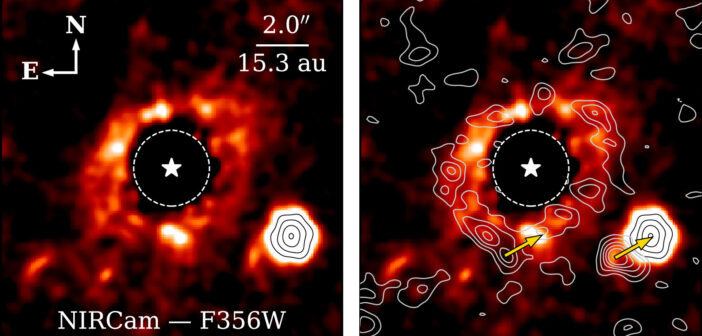JWST has achieved another first: the telescope has spotted light scattered by dust grains in the debris disk surrounding the star Fomalhaut C for the first time. These observations add to our knowledge of the planet formation process around the smallest and most common stars in our galaxy.
A Fleeting Phase
As stars and planets form out of collapsed clouds of gas and dust, nascent planetary systems pass through a short and poorly understood phase. Lasting just 10 million years, the fleeting debris disk stage is marked by collisions between protoplanets that create disks or rings of dust and rubble.
Studying debris disks is key to understanding how planetary systems form. Very few debris disks have been seen around the smallest, coolest, and most common type of star in the Milky Way — M dwarfs —and detailed observations of the few known M-dwarf debris disks have been scarce. Studies are split on whether low-mass stars are less likely to host debris disks or if these disks are simply more challenging to detect. Luckily, JWST is capable of spotting these elusive disks, and recent observations have given researchers a new perspective on a disk surrounding an M dwarf just 25 light-years away.
Disk Detected

ALMA’s view of the debris disk around Fomalhaut A. [ALMA (ESO/NAOJ/NRAO); M. MacGregor; CC BY 3.0]
Recently, a team led by Kellen Lawson (NASA’s Goddard Space Flight Center) turned JWST toward Fomalhaut C and eight other nearby M dwarfs to search for planets around these stars. In JWST’s 3.56 and 4.44 micron (1 micron = 10-6 meter) filters, the authors detected a faint disk extending beyond the star. In the shorter-wavelength filter, the outline of the disk matched the location of the debris disk seen previously by ALMA. In the longer-wavelength filter, the disk extended slightly beyond the emission seen by ALMA.
Challenging Observations
Fomalhaut C is the smallest and coolest star for which a disk has been detected in scattered light. The new observations highlight JWST’s ability to track down debris disks around small, cool stars, as well as the inherent difficulty of observing these structures: even under JWST’s watchful gaze, the star’s debris disk is seen only faintly, with background objects and noise interfering with the telescope’s view.

Fomalhaut C’s disk as seen in two different filters and with several different methods of removing diffracted starlight. Click to enlarge. [Lawson et al. 2024]
Follow-up observations of Fomalhaut C may refine our understanding of its debris disk, and future observations with JWST are sure to add to the small but critical sample of debris disks surrounding the smallest stars.
Citation
“JWST/NIRCam Detection of the Fomalhaut C Debris Disk in Scattered Light,” Kellen Lawson et al 2024 ApJL 967 L8. doi:10.3847/2041-8213/ad4496
